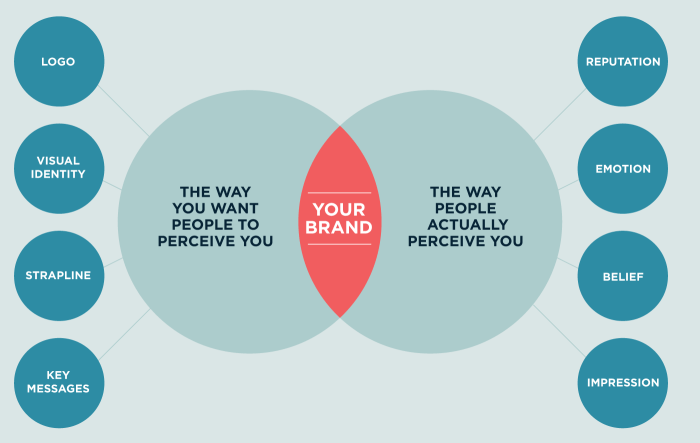Kicking off with Developing a Visual Brand Identity, this opening paragraph is designed to captivate and engage the readers, setting the tone american high school hip style that unfolds with each word.
When it comes to creating a strong brand presence, visual identity plays a key role in making a lasting impression on consumers. From logos to color schemes, every element contributes to a company’s unique identity in the market. Let’s dive into the world of visual brand identity and explore how businesses can stand out from the crowd.
Importance of Visual Brand Identity: Developing A Visual Brand Identity

Visual brand identity is crucial for a business as it serves as the face of the company, representing its values, mission, and overall personality to the audience. It helps in creating a strong connection with customers and building brand loyalty.
A strong visual brand identity can set a company apart from its competitors by making it easily recognizable and memorable. Consistency in visual elements such as logo, color palette, typography, and imagery helps in establishing a unique identity in the market.
Examples of Successful Companies with Recognizable Visual Brand Identities
- Apple: Known for its minimalist and sleek design, Apple’s visual brand identity reflects innovation and premium quality.
- Coca-Cola: With its iconic red color and timeless logo, Coca-Cola’s visual brand identity exudes happiness and refreshment.
- Nike: The swoosh logo and “Just Do It” slogan have become synonymous with Nike’s visual brand identity, representing empowerment and athleticism.
Elements of Visual Brand Identity
Visual brand identity is made up of key elements that work together to create a cohesive and memorable brand image. Each element plays a crucial role in conveying the brand message and values to the target audience. Let’s explore the significance of color palette, typography, logo, and imagery in shaping visual brand identity.
Color Palette, Developing a Visual Brand Identity
The color palette is a fundamental element of visual brand identity as colors evoke emotions and associations. Each color has its own psychological impact and can influence how consumers perceive a brand. By carefully selecting colors that align with the brand’s personality and values, companies can establish a strong visual identity that resonates with their target audience.
Typography
Typography refers to the style, size, and arrangement of text used in branding materials. The choice of fonts can convey a brand’s tone, whether it’s traditional, modern, playful, or professional. Consistent typography across all brand assets helps create a cohesive and recognizable brand identity that reinforces brand messaging.
Logo
A logo is often the most recognizable element of a brand’s visual identity. It serves as a visual representation of the brand and encapsulates its essence in a single image or wordmark. A well-designed logo is memorable, versatile, and communicates the brand’s values and personality at a glance. It plays a crucial role in brand recognition and differentiation in a crowded marketplace.
Imagery
Imagery, including photography, illustrations, and graphic elements, is another important component of visual brand identity. The visuals used in branding materials help tell the brand’s story, evoke emotions, and create a connection with the audience. Consistent use of imagery that aligns with the brand’s values and messaging reinforces brand identity and fosters brand loyalty.
Creating a Visual Brand Identity

Developing a visual brand identity involves several key steps that are essential in creating a strong and recognizable brand image. This process helps in establishing a unique identity for the brand and making it stand out in the market.
Steps in Developing a Visual Brand Identity
- Conduct a brand audit to understand current brand perception and positioning.
- Define brand values, mission, and vision to guide the visual identity creation.
- Create a brand style guide outlining logo usage, color palette, typography, and imagery guidelines.
- Design a logo that reflects the brand’s personality and values.
- Develop consistent visual elements such as color schemes, fonts, and graphics across all brand touchpoints.
- Test the visual elements with the target audience for feedback and refinement.
Importance of Aligning Visual Brand Identity with Brand Message
Aligning the visual brand identity with the brand’s overall message is crucial for maintaining brand consistency and clarity. When the visual elements such as logo, colors, and design align with the brand values and messaging, it creates a cohesive brand image that resonates with customers.
Tips for Designing a Cohesive Visual Brand Identity
- Understand your target audience and tailor the visual elements to appeal to their preferences.
- Keep the design simple and memorable to ensure easy recognition.
- Use consistent visuals across all platforms to reinforce brand recognition.
- Incorporate storytelling elements into the visual identity to create an emotional connection with the audience.
- Regularly review and update the visual brand identity to stay relevant and fresh in the market.
Consistency in Visual Branding
Maintaining consistency in visual branding is crucial for establishing a strong brand identity that customers can easily recognize and connect with. Consistency helps build trust and loyalty among consumers, as they come to associate specific visual elements with your brand.
Importance of Consistency
Consistency ensures that your brand is easily distinguishable from competitors and helps create a cohesive brand experience across all touchpoints. Whether it’s your logo, color palette, typography, or imagery, maintaining consistency helps reinforce brand recognition and recall.
- Consistent visual branding builds brand credibility and trust among consumers.
- It creates a sense of professionalism and reliability, enhancing brand perception.
- Consistency helps in establishing a strong brand presence in the market.
Examples of Inconsistency
Inconsistency in visual branding can harm a company’s image by confusing customers and diluting brand identity. For example, using different logos across various platforms or inconsistent color schemes can lead to brand fragmentation and loss of brand recognition.
- Changing brand colors frequently can create confusion and weaken brand recall.
- Using different fonts in marketing materials can make the brand appear unprofessional and disorganized.
- Having inconsistent messaging or imagery can undermine brand trust and credibility.
Ensuring Consistency
To ensure consistency across various brand touchpoints, companies can implement the following strategies:
- Create brand guidelines that Artikel specific rules for logo usage, color schemes, typography, and imagery.
- Regularly audit brand materials to ensure they align with the established guidelines.
- Train employees and stakeholders on the importance of maintaining brand consistency.
- Use a centralized asset management system to store and distribute brand assets.
- Seek feedback from customers to gauge brand perception and make necessary adjustments.